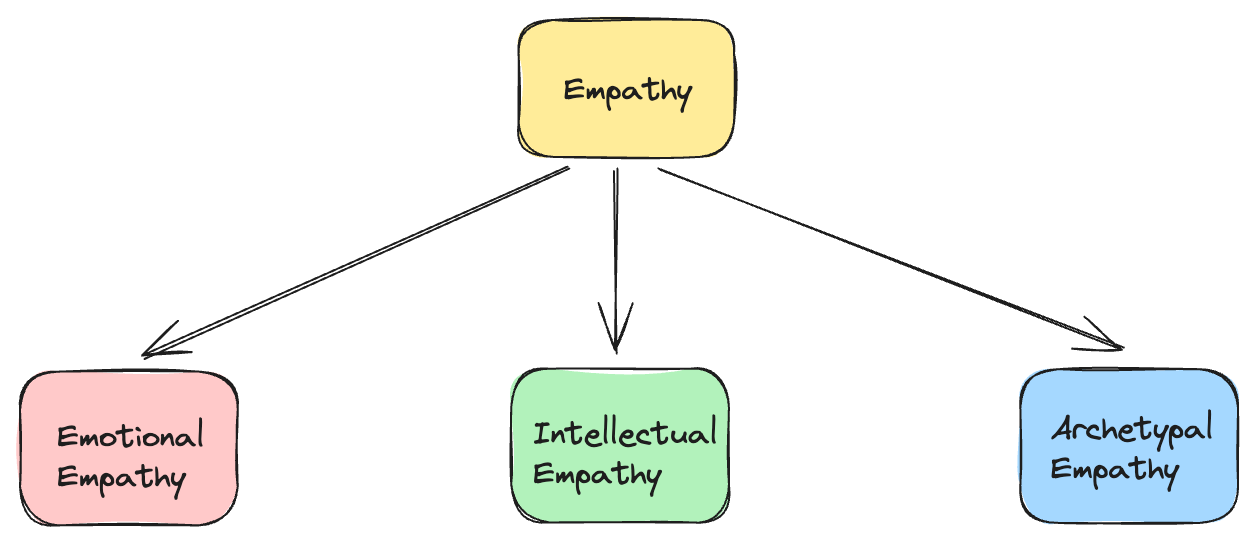#14 - A practical, three-dimensional view of empathy

On rebranding the newsletter
I've rebranded this newsletter from originally aiming at a Vietnamese audience to now a more personal identity.
- The newsletter is still about Product Management and startups.
- I will continue producing content in Vietnamese.
- I will also produce content in English, because I believe some ideas are worth sharing as widely as possible.
Empathy is an elusive topic. Although everyone knows that it is important, there hasn't been enough discussions about developing empathy in a useful way. In this article, I want to present a practical framework to look at empathy, in hopes that you may use this framework to self-evaluate and come up with actionable items for improvement.
Emotional, intellectual and archetypal empathy
Although unbacked by any scientific research (that I know of), there seems to be three dimensions of empathy.

- Emotional Empathy
- This is the ability to know what makes people emotionally triggered and what makes people comfortable.
- If you can feel the shape of people's emotional reactions to certain words or actions, and are able to trace the emotional implications, then you have emotional empathy.
- Someone with a particularly strong emotional empathy is likely to be perceived as caring, sensitive and thoughtful.
- Intellectual Empathy
- This is the ability to understand the mental models and concepts that people are using when solving a problem or dealing with a situation.
- If you can get inside people's mental headspace, and are able to communicate with them at an appropriate level of abstraction, then you have intellectual empathy.
- Someone with a particularly strong intellectual empathy is usually a good communicator/speaker/presenter.
- Archetypal Empathy
- This is the ability to grasp people at an archetypal level, abstracting from a specific individual and quickly arriving at a generic description that applies to a group of individuals.
- If you can feel the shape of people's archetypes, and are able to arrive at correct generalizations about an individual from a small sample of interactions, you have strong archetypal empathy.
- Someone with a particularly strong archetypal empathy is usually curious about people, tactical and outgoing.
Trade-offs for each dimension of empathy
It's rare that a person scores high on all dimensions. Oftentimes, there'll be one predominantly active dimension and other less active dimensions.
Having one predominantly active type of empathy has its trade-offs. The following examples are drawn from the real world, particularly some closed friends that I've worked with on a regular basis.
An example of strong emotional empathy
I have a friend whose emotional empathy is very active.
- Pros.
- He knows what make people triggered and what make them feel positive. He knows how to avoid hurting their feelings.
- This makes him a caring and caring leader who pays a lot of attention to people and their well-being.
- Being in touch with his own emotions and being intellectually capable of working through complex problems are usually strongly correlated, because emotions tend to be complex problems.
- This also makes him uniquely qualified to work on digital products that improve mental health and alleviate negative emotions.
- Those with strong emotional empathy can have profound impact on others if they can can effectively manage their own emotions.
- Cons.
- The downside is that understanding negative emotions and their implications makes it difficult for him to upset people sometimes, or be assertive when necessary.
- His ability to talk at the right level of abstraction isn't usually the most active one, so his explanations tend to be messy. But when he really focuses on articulating, he can do it just fine.
An example of strong archetypal empathy
I have another friend who demonstrate a particularly strong sense of archetypal empathy.
- Pros.
- She can usually tell what kind of person someone is, and be right about it.
- When evaluating content/products, she's able to imagine how a typical person will respond.
- Consequently, she can develop content/products that resonate with common people. This results in her ability to lead marketing and sales initiatives effectively.
- Cons.
- The downside is that sometimes she's too quick to jump to conclusions. The line between archetyping and stereotyping is blurry.
- The tendency to quickly form judgements about people may lead her to behave in assuming ways that annoy the other person.
- Sometimes she'll be perceived as the "know-it-all" girl.
An example of strong intellectual empathy
I think intellectual empathy is the most active one for me.
- Pros.
- I can understand the mental headspace of another person during conversations to adjust my own communication to the right level of abstraction. Consequently, I'm able to articulate and explain things clearly.
- I also like to mentor people. Over the years, I've helped four different individuals transition to Product Management or advance their product careers.
- Mentoring involves meeting people where they are and building a set of bridges to help them level up to where they want to be.
- Cons.
- However, I sometimes can be a bit uncaring about how people feel, which have led to instances where feelings were hurt unnecessarily.
- I'm also very bad at dealing with emotionally fragile or overly sensitive people. It's not their fault, it's just my problem.
- My archetypal empathy isn't particularly strong. I can't quickly tell what kind of person someone is, because I tend to subconsciously suppress judgement.
- This means sometimes I intellectually override my intuition about a person, and giving them too much benefits of the doubt.
What dimension of empathy is often the most active when you interact with other people? Conversely, what dimensions of empathy are less active?
How to develop each dimension of empathy?
Here are some ways that I've seen people successfully develop each type of empathy. Where I don't have a practical advice, I'll provide observations on traits that strongly correlate with each respective type of empathy.
Developing intellectual empathy
Since this is the most active dimension of empathy for me, I can talk about it with reasonable confidence.
- Writing is a one way to practice intellectual empathy.
- In order to write well, you have to articulate your thoughts clearly. In the process, you'd become familiar with the shape of thoughts that give rise to certain words, sentences or expressions.
- Having become familiar with thoughts and their associated expressions, you can detect patterns during conversations and work backwards to re-construct the kind of thoughts a person must have in order to express something in a certain way.
- Writing also acts as a forcing function. When you write, you (ideally) put yourself in other people's shoes and evaluate whether what you write is unfolding in a logical way from a different perspective. This trains the intellectual empathy muscle which will be activated when needed.
- Building your second brain is another way to develop intellectual empathy.
- A second brain, in simple terms, is a repository of mental models and ideas that are personally relevant to you. This repository is organized so that these ideas and mental models reference to each other, essentially mirroring how neurons are wired together in our brain.
- A second brain helps externalize explicit ideas and mental models, so that you can reference them during conversations with others. Vice versa, when you parse a sentence or an expression, you can use your second brain to assist in analyzing and understanding what the other person is talking about.
- As you write, don't stop at just articulating your thoughts. Take a step further and refactor your writings to a set of atomic ideas that are tightly connected to each another. Review them regularly to better recall them in conversations. Review past conversations and relate to your second brain.
- Being deeply curious about ideas helps a lot to develop intellectual empathy, because you need to be able to withhold judgement and parse complex ideas until they make sense.
- An example is when I'm reading philosophy books, I usually find myself trying to keep track of all the logical components of an argument and how they unfold within the text, even with repeated failures.
- I may re-read a paragraph 3-4 times until I can understand and re-create the argument being made in my own words. Takes a lot of time, but the intellectual exercise feels rewarding.

If you're Product Manager with a few years of experience looking to level up, building a second brain may be the way!
Developing archetypal empathy
This isn't my strongest suit, but I've observed things that seem to correlate with having strong archetypal empathy.
- Interacting with different types of people frequently seems to help with developing archetypal empathy.
- People who are social butterflies and out-going are in a good position to develop this ability. I suspect that, as you interact with more people, you're more likely to develop a set of models that help do pattern matching faster, because you have more data points to reinforce relevant characteristics.
- Insatiable curiosity about people is very predictive of strong archetypal empathy.
- Aside from the number of people you interact with, the depth of your interactions also matter. If you want to get past obvious characterizations and generalizations, you'd have to ask deep questions to uncover people's motivations and thought processes.
- It perhaps is difficult to be deeply curious, but you can practice it to some extent.
- The next time you take an Uber or a Grab, try striking conversations with the driver. I sometimes do this, but the friend that I mentioned earlier does this a lot. Sit her next to a person, and she can get them to spill out their lives.
- One time I conversed with a XanhSM driver (XanhSM is a Vietnamese electric ride-hailing platform) on my ride home, and learned about why the company's aggressive Go-to-market strategy may make sense due to some government policies. It's amazing how much you can learn from just talking to strangers.
- It's worth noting that a person can be a social butterfly without having strong archetypal empathy. This tends to be the case when they are looking for external validations due to insecurities, rather than being deeply curious about others.

The next time you take an Uber or a Grab, try having conversations with the driver.
Developing emotional empathy
- Being deeply interested in music, cinematography or any form of art is usually correlated with having strong emotional empathy.
- This is because you need to be able to parse artworks to emotions to even become interested enough to explore other aspects.
- Those who are able to do this also tends to be good at parsing people's expressions to emotions, which is the prerequisite for emotional empathy.
- Trauma can make you sensitive to negative emotions.
- If you grow up in an environment where insensitivity is not tolerated and often lead to punishments, you're likely going to be very mindful about how you express emotions, as well as how others respond to you emotionally.
- If you've been through traumatic events where you experience a lot of negative emotions, you can become sensitive to them, and are able to detect such emotions in others.
- Sensing negative emotions alone isn't enough, you need to be able to feel positive emotions and trace their implications. This means experiencing a wide array of emotions in vivid details, not just becoming sensitive to negative ones as a result of trauma.
- This can be practiced by proactively explore different types of musics, movies or relationships, so that you don't accidentally reinforce your own emotional patterns.
- Immersing in fictional books is also one good way to practice emotional empathy. In order to enjoy a fictional story, you have to imbue characters with vivid emotions, which makes it a really good exercise.
- Sometimes enjoying arts and reading fictions don't feel practical or immediately valuable, but your attempt at parsing them into emotions and implications is very valuable to build emotional empathy.

In conclusion
In this article I've presented a three-dimensional view of empathy, and provide some perspectives on how to improve them.
Please note that reality is messy, and things don't always fall neatly into places, so don't treat this framework as a definitive guide, but rather a lens to look at things.
I'd be more than happy if it is a lens that helps you realize something about yourself, and enables you to take actions to improve your life.
Have you found this blog post useful? What's your active dimension of empathy? What's the less active dimensions? What is one thing you can start doing immediately that may help you develop your less active dimensions of empathy?
Leave a comment below and let me know!
Kết nối và cập nhật các hoạt động về ngành PM của team mình:



